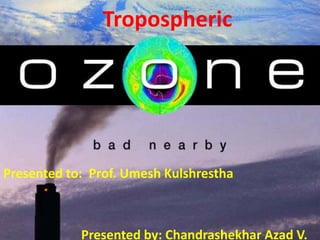
Tropospheric ozone
- 1. Tropospheric Presented to: Prof. Umesh Kulshrestha Presented by: Chandrashekhar Azad V.
- 2. Ozone • Ozone (O3), or trioxygen, is a triatomic molecule, consisting of three oxygen atoms. • It is an allotrope of oxygen that is much less stable than the diatomic allotrope(O2). • Ozone is a gas that occurs both in the Earth's upper atmosphere and at ground level. • Ozone can be "good" or "bad" for people's health and for the environment, depending on its location in the atmosphere.
- 3. Ozone OZONE TROPOSPHERIC STRATOSPHERIC • “Bad” ozone is “Good” ozone is found found • Act as pollutant Act as protective laver • Measured in ppb, Measure in DU µg/m3 (Dobson unit)
- 5. Tropospheric ozone • In the troposphere, the air closest to the Earth's surface, ground-level or "bad" ozone is a pollutant that is a significant health risk, especially for children with asthma. • It also damages crops, trees and other vegetation. • It is the main ingredient of urban smog.
- 6. Chemistry
- 7. Chemistry Ground-level or “bad” ozone is not emitted directly into the air, but is created by chemical reactions between oxides of nitrogen (NOx) and volatile organic compounds (VOC) in the presence of sunlight. Ozone is made in the troposphere by the same reaction responsible for its formation in the stratosphere. However, the source of O is different than in the stratosphere where the O atoms are made by photo dissociation of O2 at UV wavelength <240 nm. But in the troposphere only UV radiation with >290 nm is available which can yield oxygen from NO2.
- 8. Sources • The sources of tropospheric ozone are: – Influx from stratosphere – Generation by photochemical reaction in troposphere • As mentioned earlier VOC and NOx are the main precursors of ozone in the troposphere. These pollutants are emitted from industrial facilities and electrical utilities, motor vehicle exhaust, gasoline vapors and chemical solvents.
- 9. Impact of tropospheric ozone • A strong oxidant, tropospheric ozone is harmful to humans and ecosystems. • Breathing ozone can trigger a variety of health problems including chest pain, coughing, throat irritation, and congestion. It can worsen bronchitis, emphysema, and asthma. “Bad” ozone also can reduce lung function and inflame the linings of the lungs. • Ground level ozone leads to damage of agricultural fields, commercial forest yields, reduced growth and survivability of tree seedlings and also damage of the foliage of trees and other plants. • Tropospheric ozone absorbs infrared rays emanating from the earth and works as a powerful green house gas. • Ozone has its strongest green house effect in upper troposphere.
- 10. It is a known cause of photochemical smog, which disturbs human respiratory functions and plant photosynthesis. Due to its green house effect and toxicity, tropospheric ozone is known as “bad ozone”
- 12. Formation of Smog Smog is composed of many different compounds but the main composition of smog is ozone, PAN and volatile organic compounds (VOC). PAN (peroxy acetyl nitrate) is the product of VOC’s oxygen and nitrogen oxide. VOCs are uncombusted fuels, often the product of engines.
- 13. Air quality index (AQI) for ozone • The AQI is an index for reporting daily air quality. It tells you how clean or unhealthy your air is, and what associated health effects might be a concern.
- 14. Cont… NationalAmbientAir Quality Standards (NAAQS) AQI Ozone Concentration in ambient concentration air (ppb) Time Industrial, Ecologically 0-50 0-59 Pollutant weighted residential, sensitive 51-100 60-75 average rural and area other areas (notified by 101-150 76-95 central govt.) 151-200 96-115 Ozone 8 hours 100 100 201-300 116-374 (µg/m3) 1 hour 180 180 >300 >374 Source: EPA Note: An AQI of 100 for ozone corresponds to an ozone level of 75 parts per billion (averaged over 8 hours).
- 15. Conclusion • Ozone in the lower troposphere is considered to be a secondary pollutant and is called ‘bad ozone’. • Any concentration of O3 240µg/m3 and above is considered to be unhealthy for animals and human beings. 1 hour exposure is sufficient to lead to illness. • Plants have an injury threshold value of 59µg/m3 of O3 exposure for 4 hours. • Older leaves are most sensitive to O3 pollution • Both NOx and VOC emission which lead to ozone formation have been increasing in Asia over the past quarter century. Such a scenario leads to the elevation of tropospheric ozone concentration with serious consequences. • Urgent action is needed to reduce emissions through international cooperation in the Asian region.
- 16. References • Manahan E. Stanley (2005); Environmental Chemistry • Roy Sovan (2003); Environmental Science, A Comprehensive Treatise on Ecology and Environment • EPA; AQI, a guide to air quality and your health • Ashmore M.R; Assessing the future global impacts of ozone on vegetation • Acid deposition and oxidation research center Tropospheric Ozone A Growing Threat • Upadhyay S. N.; ozone the protective shield of life • Madronich, S. 1993. Tropospheric photochemistry and its response to UV changes. • http://www.airnow.gov /index .cfm • www.ucar.edu/learn/1_7_1.htm • http://www.epa.gov/oaqps001/gooduphigh/bad.html#6
- 17. Thank
